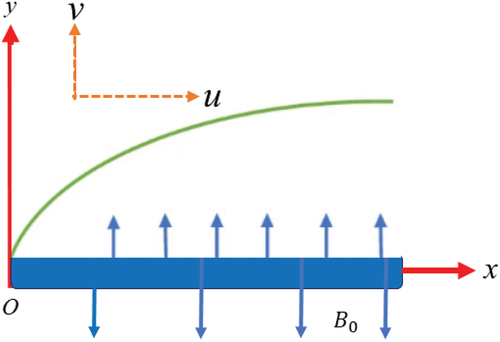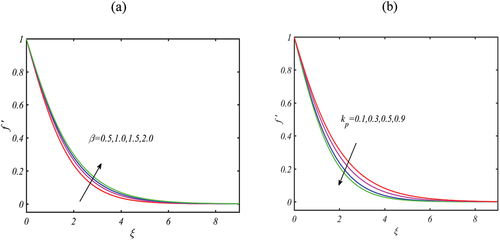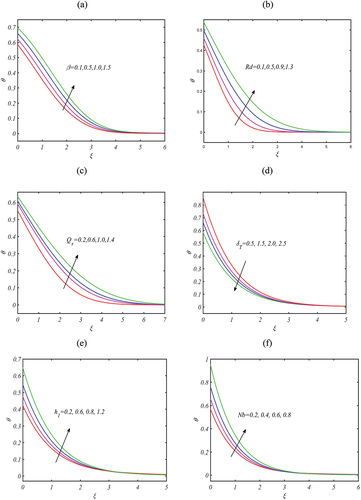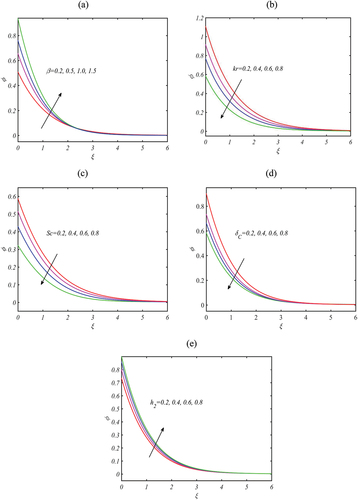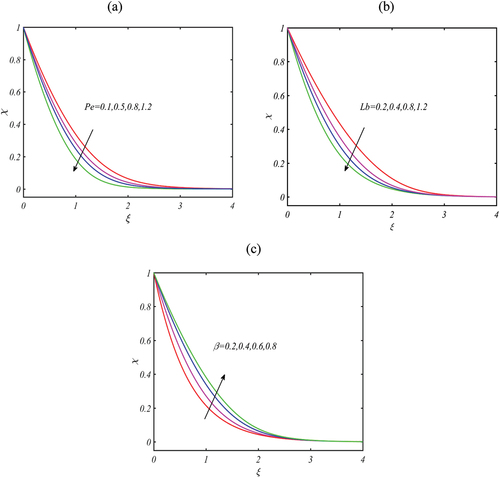 ?Mathematical formulae have been encoded as MathML and are displayed in this HTML version using MathJax in order to improve their display. Uncheck the box to turn MathJax off. This feature requires Javascript. Click on a formula to zoom.
?Mathematical formulae have been encoded as MathML and are displayed in this HTML version using MathJax in order to improve their display. Uncheck the box to turn MathJax off. This feature requires Javascript. Click on a formula to zoom.ABSTRACT
The thermal bioconvective investigation of magnetized Reiner-Rivlin nanofluid is the focus of research. The suspension of microorganisms is necessary to assess the stability of nanofluids and their consistent functioning. The heat transfer results are influenced by the radiated impact and the impacts of an external heating source. One might propose the use of the Cattaneo-Christov heat flux technique to simulate heat and mass transport difficulties. The convective boundary conditions are used for the analysis of the flow problem. The issue is modeled using a differential system. Incorporating dimensionless variables greatly simplifies the translation of the governing issue. The numerical simulation of the final system is performed using the shooting approach. The impact of settings on the thermal issue is evaluated and shown visually using graphs. Various uses of parameters in the thermal model have been presented. The heat transfer is found to increase because of the Reiner-Rivlin fluid parameter. The concentration profile decreases because of the concentration relaxation parameter. The profile of the microorganism decreases as the Peclet number increases, while the constant for Reiner-Rivlin fluid leads to increased observations.
Introduction
Nanomaterials have emerged as an attractive research area, as evidenced by novel thermal applications in various engineering and industrial frameworks. Owing to the complicated challenges of energy and heat consumption, nanomaterials are preferred as a fundamental source to overcome such issues. The nanomaterials attain anomalous thermal properties and stability performances. Due to the sustainable thermo-physical outcomes of such materials, distinct applications of nanomaterials have been observed in heat transmission devices, nuclear systems, chemical engineering, high-performance extrusion systems, electronics cooling, energy phenomena, etc. Many researchers have incorporated various aspects of nanomaterials. Nayak et al.[Citation1] utilized nanofluid thermal analysis in disk flow via a critical statistical approach. Bakthavatchalam et al.[Citation2] presented the enhanced thermal performances of nanomaterials with a combination of copper nanoparticles. Jamshed et al.[Citation3] discussed the optimal nanofluid properties associated with Casson material, and simulations were further utilized for solar energy performances. Patil et al.[Citation4] examined the features of periodically oriented magnetic force effects for the thermal diffusion flow of nanofluid. Irfan et al.[Citation5] explained the Dufour effects of enrollment for nanofluid with Joule heating effects. Jalili et al.[Citation6] executed the Hall outcomes for micropolar nanofluid with the implementation of an analytical approach. The LSM analysis for the nanofluid model with unsteady flow was focused on by Adnan et al.[Citation7] Almarashi et al.[Citation8] reported that the cooling applications in the TEG module involved a nanofluid model. Sajjad et al.[Citation9] analyzed the CFD aspects of nanofluid, and results were reported for heat recovery systems. Rasheed et al.[Citation10] focused on the micropolar nanofluid properties in flexible configurations, and modeling was further updated by using the Cattaneo-Christov theory. Sarfraz and Khan[Citation11] addressed the double diffusion investigation for nanofluid via an induced moving plate. Foukhari et al.[Citation12] evaluated the metal nanoparticles involvement in coaxial cylinder flow with heat flux. The solar energy applications based on nanofluid were studied by Sheikholeslami and Khalili.[Citation13] Ghazanfari et al.[Citation14] performed the nanomaterial analysis for the twisted flow of nanofluid, and the results were incorporated into heat exchangers. Wakif et al.[Citation15] conducted thermal measurements on titanium dioxide nanoparticles by using ethylene glycol as the base liquid and taking into account the effects of blowing. Gangadhar et al.[Citation16] conducted a heat transfer study on blood flow, including the interaction of silver nanoparticles and the extra influence of entropy production effects. Wakif et al.[Citation17] reported on the examination of Sakiadis flow of nanofluid caused by bidirectional surface. Zhang et al.[Citation18] analyzed the internally driven flow of nanofluid under the influence of Stefan’s blowing limitations and radiated impact. Khan et al.[Citation19] focused on studying the Casson nanofluid in relation to the bioconvection phenomena in stretched cylinder flow. Iqbal et al.[Citation20] conducted a theoretical analysis of the partly driven flow of Eyring-Powell nanofluid containing a suspension of microorganisms. Khan et al.[Citation21] forecasted the increase in heat transfer caused by the flow of nanofluid in the presence of microorganisms inside a spinning system. Khan et al.[Citation22] developed the entropy generating devices in Casson nanofluid to undergo leading edge ablation. Manjunatha et al.[Citation23] elucidated the function of ternary nanoparticles in augmenting the thermal efficiency of a base fluid caused by a stretched surface. Madhu et al.[Citation24] observed the variations in temperature caused by the presence of Maxwell nanofluid in an unsteady flow. Kotha et al.[Citation25] have specifically studied the influence of internal heat production on the bioconvection effect in nanofluid flow.
Nonetheless, the complicated rheology of non-Newtonian materials, diverse applications, and advantages have been observed in industrial systems. Non-Newtonian fluids play a crucial role in a wide range of technical and industrial applications. Non-Newtonian fluids play a significant role in the plastic and chemical industries, particularly with regards to fluids with varying molecular weights. The non-Newtonian character is often noticed in many substances such as human blood, paints, pharmaceuticals, nylon, and colloidal suspensions. The Reiner-Rivlin model is a specific example of non-Newtonian materials that is closely linked to the idea of dilatancy. The dilatancy idea is linked to the increase in volume during the stirring phenomena. Different foods and polymers obey the rheology of the Reiner-Rivlin model. Furthermore, the behavior of various natural as well as geological liquids is also accounted for in the Reiner-Rivlin model.[Citation26] Khan et al.[Citation27] evaluated the rheological aspects of the Reiner-Rivlin model with optimized properties. Abhijith et al.[Citation28] examined the quadratic radiated impact of Reiner-Rivlin nanofluid following buoyancy-driven flow. Rehman et al.[Citation29] studied the Jeffrey Hamel problem based on Reiner-Rivlin nanofluid via the Keller Box approach. Hiremath et al.[Citation30] suggested the slip impact for Reiner-Rivlin liquid with magnetic force association. Razaq et al.[Citation31] reported the mass flux investigation while examining the heat transfer phenomenon due to Reiner-Rivlin material. Puspanathan et al.[Citation32] reported the shrinking flow of Reiner-Rivlin fluid. Yasin et al.[Citation33] detected the slip and Hall contributions in Reiner-Rivlin fluid associated with the blood flow. The enrollment of Darcy-Forchheimer applications for Reiner-Rivlin fluid due to stenosed artery has been reported by Abdeljawad et al.[Citation34] Alsaedi et al.[Citation35] adopted the entropy generation features while investigating the heat transfer due to Reiner-Rivlin nanofluid flow.
According to the research survey mentioned above, several studies have been conducted to improve the heat transfer process by using nanofluids. However, there is currently no demonstrated work that has analyzed the bioconvective flow of Reiner-Rivlin nanofluid under the consequences of thermal transmission. The objective of this study is to investigate the bioconvective flow of Reiner-Rivlin nanofluid under the influence of thermal radiation. The elongated surface caused the movement of the nanofluid. The current thermal model incorporates innovative components that have not been previously taken into account. For instance,
The study examines the heat and mass transfer caused by MHD Reiner-Rivlin nanofluid in microbe suspensions.
The Cattaneo-Christov model is utilized to simulate the issue, incorporating new thermal relaxation and concentration relaxation effects.
Both radiated impact and external heat generation are utilized.
The effects of chemical reactions and porous media are maintained.
To analyze the problem, convective boundary conditions are employed.
The shooting approach is employed to approximate the numerical solutions.
Engineering and industrial applications are assessed based on the simplification of parameters in the physical realm.
Mathematical and physical structure of the proposed modeling
We are conducting a detailed analysis of the Reiner-Rivlin nanofluid, specifically focusing on its laminar behavior and two-dimensional flow. The assumptions of a steady flow are discussed. The presence of microorganisms in suspension also enhances the flow of nanofluids. A constant magnetic force is present. Under the premise of lower magnetic Reynolds numbers, we omitted the characteristics of the induced magnetic force.[Citation36] The permeable and extended surface facilitated the movement. The Hall effects have been omitted based on the premise that charged particles have a minimal contribution.[Citation37] The velocity function is specified by two components namely treated along
-axis and
which is entertained in normal direction as shown in . In the heat equation, the modification is included via radiated impact and an external heat source. The flow problem in a porous medium for fluid flow is governed by thermal local equilibrium, when the solid surface and the fluid inside the microscopic holes achieve the same temperature. The Cattaneo-Christov model theory is used to update the energy equation. The concentration equation has been modeled with chemical reaction interactions. The illustration of the problem is presented by the following set of PDEs[Citation26,Citation27,Citation35]:
with (kinematic viscosity),
(Reiner-Rivlin fluid coefficient),
(density),
(electrical conductivity),
(porous medium),
(permeability of porous space),
(thermal relaxation coefficient),
(thermal diffusivity),
(temperature),
(Stefan Boltzmann constant),
(Rosseland mean absorption),
(heat generation coefficient),
(ratio of nanoparticle heat capacitance to nanofluid),
(Brownian diffusion),
(thermophoretic coefficient),
(concentration relaxation coefficient),
(chemical reaction coefficient),
(ambient concentration),
(microbes density),
(chemotaxis constant) and
(swimming cells speed).
The problem is addressed through analyzing the following flow conditions:
where (thermal conductivity),
(heat transfer coefficient) and
(mass transfer coefficient).
Utilizing novel similarity variables as outlined:[Citation26,Citation35]
where represents the characteristic temperature while
is characteristic concentration.
Implementing variables (7) on Eqs. (1–6) lead to:
with
with (Reiner-Rivlin fluid parameter),
(porosity parameter),
(Hartmann number),
(radiation parameter),
(Brownian constant),
(thermophoresis parameter),
(external heat source),
(thermal relaxation constant),
(concentration relaxation constant),
(Schmidt number),
(chemical reaction),
(Peclet number),
(bioconvective Lewis number),
(thermal Biot number)
(concentration Biot number),
(microorganisms difference coefficient).
Expressions for Nusselt number , Sherwood number
and motile density number
in dimensionless form:[Citation26,Citation27,Citation35]
Numerical simulations
The specified issue is numerically evaluated using the shooting approach. The shooting strategy is predicated on the transformation of higher order differential equations into a first order system. This approach utilizes an iterative procedure to refine and solve initial estimates until the result satisfies the boundary requirements to a reasonable percentage. The shooting approach is more efficient in handling nonlinearities compared to other numerical systems. The differential equations are converted into a first-order system using the following transformation:
Validation of results
The produced numerical data is compared with the findings reported by Turkyilmazoglu[Citation38] in . Both investigations have reached an appropriate level of agreement.
Table 1. Comparison of numerical findings with investigation of Turkyilmazoglu[Citation38] when
Discussion
The illustration of physical phenomenon is visualized with fluctuation of governed parameters. The problem being modeled is based on theoretical flow constraints, which result in the assignment of fixed numerical values to the related parameters, such as:[Citation39,Citation40]
,
,
,
,
and
demonstrating the visualization of velocity rate
by incorporating the effects of Reiner-Rivlin fluid parameter
. The increasing detection in profile of
is exhibited under the variation of
. The increasing effects of
contributes low fluid resistance which enhances the velocity in given regime. describes the contribution of porosity coefficient
on
. Lower truncation in
due to different range of
is executed. Such lower outcomes are physically announcing due to less permeability of porous region.
determining the insight investigation of temperature profile by increasing the role of Reiner-Rivlin fluid parameter
. An enhancement is preserved in profile of
due to larger
. Such features are examined due to distinct fluid rheology. contributing the justification for radiation parameter Rd on behavior of
. An increasing change in
is observed for Rd. The radiation phenomenon is an external source of heat enhancement due to electromagnetic waves. utilizing the analysis for heat source
on
. An up leading change in
subject to
has been preserved. The outcomes listed in defining the role of thermal relaxation coefficient
on
. Low impact is associated to increasing values of
has been claimed. discussing the analysis for thermal Biot constant h1 on
. The improved rate of heat transfer is announced due to h1. These enhanced results are due to relation of h1 with heat transfer coefficient. announced that heat transfer is increasing due to Brownian parameter Nb. The Brownian parameter describes the random fluid motion.
predicts the change in concentration profile by enlarging
. The rate of concentration is increasing gradually under the dynamic values of
. conveying the analysis for
with effective values of reaction constant kr. Less analysis in profile of
due to kr is observed. disclosing the prediction of
against Schmidt number Sc. With enhancing Sc, less mass diffusivity resulted which declined the concentration. convincing the results for different values of concentration relaxation constant
. attributes the concentration enhances for concentration for concentration Biot number h2.
prescribed the features of Peclet number Pe on microorganisms’ profile . It is examined that
reduces for Pe. In fact, changing Pe leading to less motile density which resulting slow rate of microorganism’s field. suggested that
reduces for bioconvective Lewis constant. presents the prominent role of
on
. An up rise determination of
is revealed for increasing
.
prescribed the results for illustrating Nusselt number, Sherwood number and motile density number by varying different coefficients. These quantities decrease for and
and
. Large variation is noted for
and
.
Table 2. Numerical impact of parameters on ,
and
.
Conclusions
We have theoretically investigated the bioconvective aspects of Reiner-Rivlin fluid with the incorporation of an external heating source and chemical reaction features. It is strongly encouraged to include Cattaneo-Christov expressions into heat equations. The solution is obtained by the use of the shooting approach. Physical outcomes are analyzed by assessing changes in parameters. Here are some noteworthy findings:
The velocity profile demonstrates the Reiner-Rivlin fluid parameter’s growing impact.
The velocity profile decreased because of the porosity parameter.
The Reiner-Rivlin fluid parameter and the addition of an external heat source both contribute to an increased rate of heat transmission.
When the thermal relaxation constant is greater, there is a reduction in the change of the thermal profile.
The concentration field diminishes as the chemical reaction parameter and concentration relaxation constant decrease.
The thermal Biot number enhances the temperature field, whereas the concentration Biot number enhances the concentration field.
When the bioconvective Lewis number is low, the profile of the microbe drops, but it remains constant for Reiner-Rivlin fluid.
Nomenclature
| = | kinematic viscosity | |
| = | Reiner-Rivlin fluid coefficient | |
| = | density | |
| = | electrical conductivity | |
| = | porous medium | |
| = | permeability of porous space | |
| = | thermal relaxation coefficient | |
| = | thermal diffusivity | |
| = | temperature | |
| = | Stefan Boltzmann | |
| = | Rosseland mean absorption | |
| = | heat generation coefficient | |
| = | ratio of nanoparticle heat capacitance to nanofluid | |
| = | Brownian diffusion | |
| = | thermophoretic coefficient | |
| = | concentration relaxation coefficient | |
| = | chemical reaction coefficient | |
| = | ambient concentration | |
| = | microbes density | |
| = | chemotaxis constant | |
| = | swimming cells speed | |
| = | thermal conductivity | |
| = | heat transfer coefficient | |
| = | mass transfer coefficient | |
| = | Reiner-Rivlin fluid parameter | |
| = | porosity parameter | |
| = | Hartmann number | |
| = | radiation parameter | |
| = | Brownian constant | |
| = | thermophoresis parameter | |
| = | external heat source | |
| = | thermal relaxation constant | |
| = | concentration relaxation constant | |
| = | Schmidt number | |
| = | chemical reaction | |
| = | Peclet number | |
| = | bioconvective Lewis number | |
| = | thermal Biot number | |
| = | concentration Biot number | |
| = | microorganisms difference coefficient | |
| = | Nusselt number | |
| = | Sherwood number | |
| = | motile density number | |
| = | characteristic temperature | |
| = | characteristic concentration. |
Disclosure statement
No potential conflict of interest was reported by the author(s).
References
- Nayak, M. K.; Shaw, S.; Ijaz Khan, M.; Pandey, V. S.; Nazeer, M. Flow and Thermal Analysis on Darcy-Forchheimer Flow of Copper-Water Nanofluid Due to a Rotating Disk: A Static and Dynamic Approach. J. Mater. Res. Technol. 2020, 9(4), 7387–7408. DOI: 10.1016/j.jmrt.2020.04.074.
- Bakthavatchalam, B.; Habib, K.; Saidur, R.; Saha, B. B.; Irshad, K. Comprehensive Study on Nanofluid and Ionanofluid for Heat Transfer Enhancement: A Review on Current and Future Perspective. J. Mol. Liq. 2020, 305(112787), 112787. DOI: 10.1016/j.molliq.2020.112787.
- Jamshed, W.; Uma Devi, S. S.; Goodarzi, M.; Prakash, M.; Sooppy Nisar, K.; Zakarya, M.; Abdel-Aty, A.-H. Evaluating the Unsteady Casson Nanofluid Over a Stretching Sheet with Solar Thermal Radiation: An Optimal Case Study. Case Stud. Therm. Eng. 2021, 26(101160), 101160. DOI: 10.1016/j.csite.2021.101160.
- Patil, P. M.; Benawadi, S.; Momoniat, E. Thermal Analysis of Bioconvective Nanofluid Flow Over a Sphere in Presence of Multiple Diffusions and a Periodic Magnetic Field. Case Stud. Therm. Eng. 2023, 51(103569), 103569. DOI: 10.1016/j.csite.2023.103569.
- Irfan, M.; Anwar, M. S.; Kebail, I.; Khan, W. A. Thermal Study on the Performance of Joule Heating and Sour-Dufour Influence on Nonlinear Mixed Convection Radiative Flow of Carreau Nanofluid. Tribol. Int. 2023, 188(108789), 108789. DOI: 10.1016/j.triboint.2023.108789.
- Jalili, P.; Narimisa, H.; Jalili, B.; Shateri, A.; Ganji, D. D. A Novel Analytical Approach to Micro-Polar Nanofluid Thermal Analysis in the Presence of Thermophoresis, Brownian Motion and Hall Currents. Soft Comput. 2023, 27(2), 677–689. DOI: 10.1007/s00500-022-07643-2.
- Adnan, N.; Said, A.; M, N. LSM Analysis of Thermal Enhancement in KKL Model-Based Unsteady Nanofluid Problem Using CCM and Slanted Magnetic Field Effects. J. Therm. Anal. Calorim. 2024, 149(2), 839–851. DOI: 10.1007/s10973-023-12801-1.
- Almarashi, A.; Hamali, W.; Mechai, I.; Qahiti, R.; Almusawa, M. Y.; AL-Bonsrulah, H. A. Z.; Elbashir, N. B. M. Photovoltaic Thermal Solar System in Presence of Nanofluid Cooling Analyzing Environmental Parameter in Existence of TEG Module. J. Therm. Anal. Calorim. 2024, 149(6), 2739–2747. DOI: 10.1007/s10973-023-12827-5.
- Sajjad, R.; Hussain, M.; Khan, S. U.; Rehman, A.; Khan, M. J.; Tlili, I.; Ullah, S. CFD Analysis for Different Nanofluids in Fin Prolonged Heat Exchanger for Waste Heat Recovery. S. Afr. J. Chem. Eng. 2024, 47, 9–14. DOI: 10.1016/j.sajce.2023.10.005.
- Rasheed, H. U.; Shah, Q.; Khan, J.; Abbas, T.; Khan, W.; Mohmand, M. I. Physical Insight into Thermal Analysis of Magnetohydrodynamic Stagnation Point Flow of Micropolar Nanofluid Across a Flexible Surface Equipped with Porous Medium and Fourier and Fick’s Law. Heat Trans. 2023. DOI: 10.1002/htj.22962.
- Sarfraz, M.; Khan, M. Cattaneo-Christov Double Diffusion Based Heat Transport Analysis for Nanofluid Flows Induced by a Moving Plate. Numer. Heat Transf. A 2024, 85(3), 351–363. DOI: 10.1080/10407782.2023.2186551.
- Foukhari, Y.; Sammouda, M.; Driouich, M. MHD Natural Convection in an Annular Space Between Two Coaxial Cylinders Partially Filled with Metal Base Porous Layer Saturated by Cu–Water Nanofluid and Subjected to a Heat Flux. J. Therm. Anal. Calorim. 2024, 149(1), 131–144. DOI: 10.1007/s10973-023-12709-w.
- Sheikholeslami, M.; Khalili, Z. Simulation for Impact of Nanofluid Spectral Splitter on Efficiency of Concentrated Solar Photovoltaic Thermal System. Sustain. Cities Soc. 2024, 101(105139), 105139. DOI: 10.1016/j.scs.2023.105139.
- Ghazanfari, V.; Taheri, A.; Amini, Y.; Mansourzade, F. Enhancing Heat Transfer in a Heat Exchanger: CFD Study of Twisted Tube and Nanofluid (Al2o3, Cu, CuO, and TiO2) Effects. Case Stud. Therm. Eng. 2024, 53(103864), 103864. DOI: 10.1016/j.csite.2023.103864.
- Wakif, A.; Alshehri, A.; Muhammad, T. Influences of Blowing and Internal Heating Processes on Steady MHD Mixed Convective Boundary Layer Flows of Radiating Titanium Dioxide‐Ethylene Glycol Nanofluids. Z. Angew. Math. Mech. 2024, 104(4), e202300536. DOI: 10.1002/zamm.202300536.
- Gangadhar, K.; Shashidhar Reddy, K.; Prameela, M.; Wakif, A. Generation of Entropy on Blood Conveying Silver Nanoparticles Embedded in Curved Surfaces. Proc. Inst. Mech. Eng. Part E J. Process Mech. Eng. 2024. DOI: 10.1177/09544089231224523.
- Wakif, A.; Zaydan, M.; Sehaqui, R. Further Insights into Steady Three-Dimensional MHD Sakiadis Flows of Radiating-Reacting Viscoelastic Nanofluids via Wakif’s-Buongiorno and Maxwell’s Models. J.Umm Al-Qura Univ. Appll. Sci. 2024, 1–13. DOI: 10.1007/s43994-024-00141-1.
- Zhang, R.; Zaydan, M.; Alshehri, M.; Raju, C. S. K.; Wakif, A.; Shah, N. A. Further Insights into Mixed Convective Boundary Layer Flows of Internally Heating Jeffery Nanofluids: Stefan’s Blowing Case Study with Convective Heating and Thermal Radiation Impressions. Case Stud. Thermal Eng. 2024, 55, 104121. DOI: 10.1016/j.csite.2024.104121.
- Khan, N. S.; Humphries, U. W.; Kumam, W.; Kumam, P.; Muhammad, T. Bioconvection Casson Nanoliquid Film Sprayed on a Stretching Cylinder in the Portfolio of Homogeneous‐Heterogeneous Chemical Reactions. Z. Angew. Math. Mech. 2022, 102(5), e202000222. DOI: 10.1002/zamm.202000222.
- Iqbal, M.; Khan, N. S.; Khan, W.; Hassine, S. B. H.; Alhabeeb, S. A.; Khalifa, H. A. E.-W. Partially Ionized Bioconvection Eyring-Powell Nanofluid Flow with Gyrotactic Microorganisms in Thermal System. Therm. Sci. Eng. Prog. 2023, 47, 102283. DOI: 10.1016/j.tsep.2023.102283.
- Khan, N. S.; Humphries, U. W.; Kumam, W.; Kumam, P.; Muhammad, T. Dynamic Pathways for the Bioconvection in Thermally Activated Rotating System. Biomass Convers. Biorefin. 2022, 14(7), 8605–8623. DOI: 10.1007/s13399-022-02961-9.
- Khan, N. S.; Humphries, U. W.; Kumam, W.; Kumam, P.; Muhammad, T. Assessment of Irreversibility Optimization in Casson Nanofluid Flow with Leading Edge Accretion or Ablation. Z. Angew. Math. Mech. 2022, 102(10), e202000207. DOI: 10.1002/zamm.202000207.
- Manjunatha, S.; Puneeth, V.; Gireesha, B. J.; Chamkha, A. Theoretical Study of Convective Heat Transfer in Ternary Nanofluid Flowing Past a Stretching Sheet. J. Appl. And Comput. Mechanics 2022, 8(4), 1279–1286.
- Madhu, M.; Kishan, N.; Chamkha, A. J. Unsteady Flow of a Maxwell Nanofluid Over a Stretching Surface in the Presence of Magnetohydrodynamic and Thermal Radiation Effects. Propulsion And Power Res. 2017, 6(1), 31–40. DOI: 10.1016/j.jppr.2017.01.002.
- Kotha, G.; Kolipaula, V. R.; Venkata Subba Rao, M.; Penki, S.; Chamkha, A. J. Internal Heat Generation on Bioconvection of an MHD Nanofluid Flow Due to Gyrotactic Microorganisms. Eur. Phys. J. Plus. 2020, 135(7), 600. DOI: 10.1140/epjp/s13360-020-00606-2.
- Alarabi, T. H.; Mahdy, A.; Abo-Zaid, O. A. Distinctive Approach for MHD Natural Bioconvection Flow of Reiner–Rivlin Nano-Liquid Due to an Isothermal Sphere. Case Stud. Therm. Eng. 2024, 55(104179), 104179. DOI: 10.1016/j.csite.2024.104179.
- Khan, S. A.; Hayat, T.; Alsaedi, A. Bioconvection Entropy Optimized Flow of Reiner-Rivlin Nanoliquid with Motile Microorganisms. Alex Eng J. 2023, 79, 81–92. DOI: 10.1016/j.aej.2023.07.069.
- Abhijith, P.; Sabu, A. S.; Areekara, S.; Mathew, A. Nonlinear Buoyancy Driven MHD Reiner–Rivlin Nanoliquid Flow with Quadratic Radiation. Numer. Heat Transf. A 2023, 2023, 1–16. DOI: 10.1080/10407782.2023.2294051.
- Rehman, S.; Almubaddel, F. S.; Mahrous, Y. M.; Alsadoun, F. A.; Abouzied, A. S.; Hashim. A Generalization of Jeffrey-Hamel Problem to Reiner-Rivlin Model for Energy and Thermodynamic Analysis Using Keller-Box Computational Framework. Case Stud. Therm. Eng. 2023, 50(103462), 103462. DOI: 10.1016/j.csite.2023.103462.
- Hiremath, P. N.; Shettar, B. M.; Madhukesh, J. K.; Ramesh, G. K. Radiative Flux and Slip Flow of Reiner–Rivlin Liquid in the Presence of Aligned Magnetic Field. J. Therm. Anal. Calorim. 2023, 148(21), 11945–11954. DOI: 10.1007/s10973-023-12482-w.
- Razaq, A.; Khan, S. A.; Hayat, T.; Alsaedi, A. Entropy Optimization in Radiative Flow of Reiner-Rivlin Material with Heat Source and Modified Cattaneo-Christov Heat and Mass Fluxes. Case Stud. Therm. Eng. 2023, 45(102985), 102985. DOI: 10.1016/j.csite.2023.102985.
- Puspanathan, S.; Naganthran, K.; Hashmi, M. M.; Hashim, I.; Momani, S. Numerical Investigation of Reiner–Rivlin Fluid Flow and Heat Transfer Over a Shrinking Rotating Disk. Chin. J. Phys. 2024, 88, 198–211. DOI: 10.1016/j.cjph.2024.01.021.
- Yasin, M.; Hina, S.; Naz, R. Influence of Hall and Slip on MHD Reiner-Rivlin Blood Flow Through a Porous Medium in a Cylindrical Tube. Soft Comput. 2024, 28(4), 2799–2810. DOI: 10.1007/s00500-023-09538-2.
- Abdeljawad, T.; Sohail, M.; Mostapha, D. R. Impacts of Hall Current and Joule Heating of Cattaneo-Christov on Peristaltic Stenosed Artery of Reiner-Rivlin Liquid Through Darcy-Forchheimer Feature. Ain Shams Eng. J. 2024, 15(5), 102679. DOI: 10.1016/j.asej.2024.102679.
- Alsaedi, A.; Razaq, A.; Hayat, T.; Khan, S. A. Modeling and Simulation of Cattaneo-Christov Fluxes in Entropy Induced Flow Through Reiner-Rivlin Fluid Conveying Tiny Particles. Alex Eng J. 2023, 74, 1–19. DOI: 10.1016/j.aej.2023.05.017.
- Krishna, M. V.; Chamkha, A. J. Hall and Ion Slip Effects on Unsteady MHD Convective Rotating Flow of Nanofluids—Application in Biomedical Engineering. J. Egypt. Math. Soc. 2020, 28(1), 1. DOI: 10.1186/s42787-019-0065-2.
- Kumar, B.; Seth, G. S.; Nandkeolyar, R.; Chamkha, A. J. Outlining the Impact of Induced Magnetic Field and Thermal Radiation on Magneto-Convection Flow of Dissipative Fluid. Int. J. Therm. Sci. 2019, 146(106101), 106101. DOI: 10.1016/j.ijthermalsci.2019.106101.
- Turkyilmazoglu, M. The Analytical Solution of Mixed Convection Heat Transfer and Fluid Flow of a MHD Viscoelastic Fluid Over a Permeable Stretching Surface. Int. J. Mech. Sci. 2013, 77, 263–268. DOI: 10.1016/j.ijmecsci.2013.10.011.
- Irfan, M.; Bhatti, M. M. Effects of Arrhenius Kinetic on the Magnetized Nanofluid Flow Through a Porous Stretchable Cylinder with Slip Conditions. Ener. Sour. Recov. Util. Environ. Eff. 2024, 46(1), 1979–1995. DOI: 10.1080/15567036.2024.2302004.
- Hassan, M.; Chunwei, Z.; Firdous, A.; Bhatti, M. M. Viscoelastic Fluid Flow on Variable Thickness Sheets Using a Three-Element Viscous Model. Int. J. Model. Simul. 2024, 2024, 1–12. DOI: 10.1080/02286203.2024.2338583.

